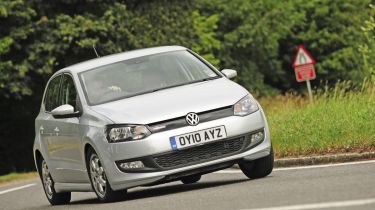VW Polo Bluemotion 1.2 TDI
The latest Bluemotion model continues to set efficiency benchmarks - but can it compete with the Ford's lively driving dynamics?
THE latest Volkswagen Polo got off to a slow start, trailing the Ford Fiesta, Renault Clio and Mazda 2 on its road test debut. But it’s gaining momentum.
A model with the new 1.2-litre TSI engine took revenge on the Clio in a recent twin test, while the hot GTI saw off SEAT’s Ibiza Bocanegra too. Now, the green-minded BlueMotion variant has arrived…
Video: watch CarBuyer's video review of the VW Polo
[[{"type":"media","view_mode":"content_narrow","fid":"68451","attributes":{"alt":"","class":"media-image"}}]]
A range of visual tweaks mark it out from regular versions, but the BlueMotion doesn’t look any worse for its gloss black grille, rear spoiler and aerodynamic front bumper.
In a further attempt to reduce drag, the BlueMotion gets more aerodynamic door mirrors, plus underbody panels to smooth the flow of air beneath. Only the fussy lightweight alloy wheels detract from the smart, grown-up styling.
VW has put the BlueMotion on a weight-saving diet, too, but jump inside, and there is little obvious evidence of this. The regular Polo’s familiar high-quality upper dash and simple cabin design remain, while standard equipment includes a leather steering wheel and cruise control – neither of which is fitted to the Ford.
Rear space is on a par with the Fiesta, and boot capacity is virtually identical. However, the Polo features a simple single-piece rear seat rather than the more versatile split-folding set-up in the Fiesta.
Maximising fuel economy is the aim of both of these cars, and to make the most of its lightweight design and aero additions, the VW gets stop-start and brake regeneration.
Used - available now

2016 BMW
5 Series
107,200 milesAutomaticDiesel2.0L
Cash £9,000
2023 Audi
e-tron
48,154 milesAutomaticElectric
Cash £18,000
2015 Volkswagen
Golf GTD
84,621 milesAutomaticDiesel2.0L
Cash £12,000
2016 Tesla
Model S
78,000 milesAutomaticElectric
Cash £18,999Power comes from a new 1.2-litre three-cylinder diesel engine, which produces 74bhp. That’s 20bhp less than its rival’s unit, although the Polo takes the upper hand immediately as it emits CO2 at a miserly rate of only 91g/km – meaning you pay no road tax.
Around town, the less powerful VW copes with the cut and thrust of rush-hour traffic, although you have to drive it much harder than the Ford to keep up with the flow. Our performance figures back up this impression, as the VW trailed the Ford by two seconds in the sprint from 0-60mph, recording a time of 14.6 seconds.
In-gear punch in the higher ratios is also in short supply, as the Polo took a leisurely 14 seconds to accelerate from 50-70mph in fifth; the lively Fiesta completed this assessment 2.9 seconds faster. The lack of urge isn’t so much of an issue at constant cruising speeds and motorway pace. But the VW is less refined than its rival, and uphill stretches of road will have you reaching for a lower ratio.
When you leave the dual carriageway behind, the Polo fails to put a smile on your face in the same way as the Ford. Its steering doesn’t provide as much feel as the engaging set-up in the Fiesta, body roll through corners is more pronounced and the gearshift is notchy; the ECOnetic delivers much slicker changes.
The VW still puts in a solid performance on the road, and its effective and confidence-inspiring brakes leave the Ford’s in the shade. But the poor low-speed ride highlights bumps that the Fiesta glides across and the low-rolling-resistance tyres provide less grip in corners.
These models stand or fall by their efficiency, though, and the Polo is not only the cleaner car, but also more economical. In its time with us, it returned 47.8mpg. This looks even more impressive when you consider that it includes the period we spent at the track carrying out our performance tests.
The BlueMotion isn’t without compromises – the firm low-speed ride and limited straight-line speed count against it. But it’s cheaper to buy than its rival and doesn’t cost as much to run – so this test is set to be close.
Details
Chart position: 2
WHY: BlueMotion range has become an established part of VW’s line-up – and this diesel Polo has claimed 80mpg potential.







